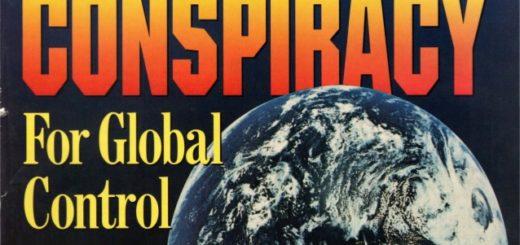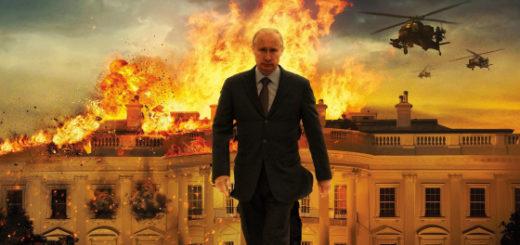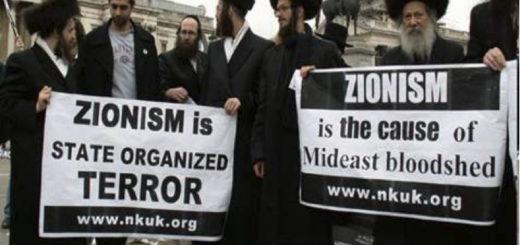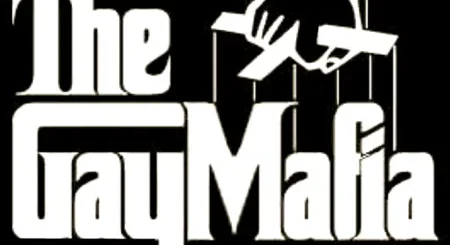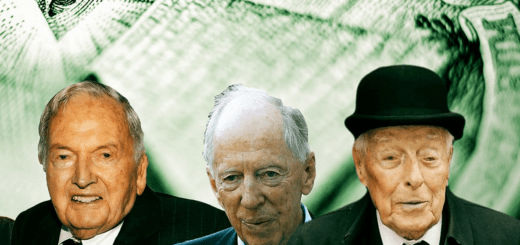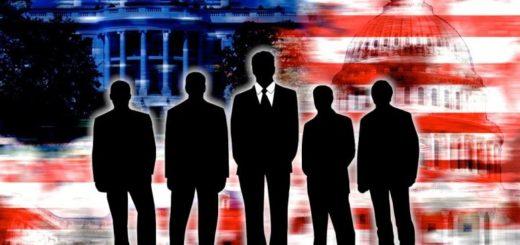CIA Tied to Marxist Groups
CIA had secretly funded the National Student Association (NSA) as a front group in the battle to win the allegiance of young student leaders from Marxist- and KGB-controlled fronts. The American press picked up the trail and ran a large number of stories exposing the agency’s various ties to foundations, think tanks, labor unions, and universities. The CIA’s whole system of anticommunist fronts in Europe, Asia, and South America was essentially blown.[19][20]
The CIA: Criminals in Action
[Editor’s Note: It’s important to recall the deathbed revelations made by ex-Nazi Commando Otto Skorzeny in late 1999 to Eric Bermen, author of The Bush Connection. Skorzeny told Bermen that he, Skorzeny, and Nazi-infiltrated covert agent George Herbert Walker Bush, the 41st President of the United States, were at the very top of the organization of and operational implementation of the Central Intelligence Agency and played leading roles in CIA assassination operations, such as the JFK murder, for a half century following its creation in 1947…Ken Adachi]
http://educate-yourself.org/cn/ciafromsourcewatch15jul08.shtml
July 15, 2008
The CIA: Criminals in Action (July 15, 2008)
Forward courtesy of Dr. Kanya <drkanya@gmail.com>
From SourceWatch
(Redirected from CIA)Jump to: navigation, search
The Central Intelligence Agency was created in 1947 with the signing of the National Security Act of 1947[1][2] (PL 235 – 61 Stat. 496; U.S.C. 402) by President Harry S. Truman. The Act was amended by the National Security Act Amendments of 1949 (63 Stat. 579; 50 U.S.C. 401 et seq.).
“The National Security Act charged the Director of Central Intelligence (DCI) with coordinating the nation’s intelligence activities and correlating, evaluating and disseminating intelligence which affects national security … The CIA is an independent agency, responsible to the President through the DCI, and accountable to the American people through the intelligence oversight committees of the U.S. Congress.”[3]
[edit]
Personnel
- Michael V. Hayden[4], Director
- Vice Admiral Albert M. Calland, III[5], Deputy Director of the CIA
- (Vacant), Associate Director of the CIA for Homeland Security, Office of the Director of the CIA;
- (Vacant), Associate Director of the CIA for Military Support, Office of the Director of the CIA;
- (Unknown), Executive Director of the CIA
- John A. Kringen[6], Director of Intelligence
- (Undercover), Director of the National Clandestine Service
- Stephanie L. O’Sullivan[7], Director of Science and Technology
- Stephanie Danes Smith[8], Director of Support
- Paul Johnson, Director Center for the Study of Intelligence
- John A. Rizzo, Acting General Counsel, Office of General Counsel
- John L. Helgerson, Inspector General, Office of the Inspector General
- Jennifer Millerwise Dyck[9], Director of the Office of Public Affairs
Controversy
Techniques
Intelligence collection comprises both analysis of open-sources and covert gathering of information. The covert operations often entail the calculated and deliberate violation of foreign or international laws. This extra-legal dimension of intelligence is highlighted by new legislation introduced in the U.S. Senate, which is intended to help preserve it against the encroachment of international law. Within the Central Intelligence Agency, “hundreds of employees on a daily basis are directed to break extremely serious laws in countries around the world in the face of frequently sophisticated efforts by foreign governments to catch them,” according to a 1996 House Select Committee on Intelligence report.[10]
“A safe estimate is that several hundred times every day (easily 100,000 times a year) [intelligence] officers engage in highly illegal activities (according to foreign law)….” (IC21: Intelligence Community in the 21st Century, p. 205). Ironically, DCI George Tenet suggested in a May 25 speech to graduates of Johns Hopkins University that U.S. intelligence can serve “to help strengthen the rule of law in countries whose stability is threatened by unfettered crime.” But in practice, defying the rule of law is the CIA’s modus operandi “in countries around the world.”[11]
Black budget
“The CIA has the unique legal ability among all US government departments and agencies to generate funds through appropriations of other federal government agencies and other sources ‘without regard to any provisions of law’ and without regard to the intent behind Congressional appropriations. Every year, billions of dollars of Congressional appropriations are diverted from their Congressionally sanctioned purposes to the CIA and DoD based intelligence agencies without knowledge of the public and with the collusion of Congressional leaders. The covert world of ‘black programs’ acts with virtual impunity, overseen and regulated by itself, funding itself through secret slush funds, and is free of the limitations that come from Congressional oversight, proper auditing procedures and public scrutiny.” The CIA black budget is annually in the vicinity of 1.1 trillion dollars – a truly staggering figure when one considers that the DoD budget for 2004 will be approximately 380 billion dollars.[12]
Outsourcing the NCS
“Intelligence professionals,” R.J. Hillhouse wrote July 8, 2007, in the Washington Post[13], “tell me that more than 50 percent of the National Clandestine Service (NCS) — the heart, brains and soul of the CIA — has been outsourced to private firms such as Abraxas[14], Booz Allen Hamilton, Lockheed Martin and Raytheon.
“These firms recruit spies, create non-official cover identities and control the movements of CIA case officers. They also provide case officers and watch officers at crisis centers and regional desk officers who control clandestine operations worldwide. As the Los Angeles Times first reported [in October 2006], more than half the workforce in two key CIA stations in the fight against terrorism — Baghdad and Islamabad, Pakistan — is made up of industrial contractors, or ‘green badgers,’ in CIA parlance.
“Intelligence insiders say that entire branches of the NCS have been outsourced to private industry. These branches are still managed by U.S. government employees (‘blue badgers’) who are accountable to the agency’s chain of command. But beneath them, insiders say, is a supervisory structure that’s controlled entirely by contractors; in some cases, green badgers are managing green badgers from other corporations,” Hillhouse wrote.
Intelligence-university complex
Writing in Covert Action Bulletin, Robert Witanek, argued that the CIA operatives “with academic cover have worked extensively on campuses around the world.”[15][16]
The Intelligence Authorization Act is an annual bill that allocates funds for intelligence agencies. When congress passed the 2004 legislation and President Bush signed it into law, the bill drew fire from many corners because it expanded the Patriot Act and was passed with little debate. But there was another provision in the legislation that received almost no attention. Section 318 of the bill appropriated 4 million dollars to fund a pilot program called the Pat Roberts Intelligence Scholars Program, known as PRISP. The program is named after Kansas Republican Pat Roberts, who is chairman of the Senate Select Committee on Intelligence. The scholarship was created in order to train intelligence operatives and analysts in American universities for careers in the CIA and other agencies. The students receive up to $50,000 dollars over a two-year period and are required to complete at least one summer internship at the CIA or other approved agencies. The program is veiled in secrecy – there are no public lists of the participants and there is no requirement that they disclose their affiliation to their professors.[17][18] Ramparts magazine, a left-wing publication, revealed that the CIA had secretly funded the National Student Association (NSA) as a front group in the battle to win the allegiance of young student leaders from Marxist- and KGB-controlled fronts. The American press picked up the trail and ran a large number of stories exposing the agency’s various ties to foundations, think tanks, labor unions, and universities. The CIA’s whole system of anticommunist fronts in Europe, Asia, and South America was essentially blown.[19][20]
CIA-Nazi connection
The CIA arranged to have hundreds of Nazi war criminals secretly brought into the US to teach their skills to US agents. Under top secret programs such as Project Paperclip, these criminals were given aliases and protection from the law in exchange for their services. “The American government worked closely with Nazi war criminals and collaborators, allowing many of them to live in the United States after World War II.”—New York Times, January 30, 2005.[21].
Saddam Hussein as 40-year CIA asset
United Press International has interviewed almost a dozen former U.S. diplomats, British scholars and former U.S. intelligence officials to piece together the following account. While many have thought that Saddam first became involved with U.S. intelligence agencies at the start of the September 1980 Iran-Iraq war, his first contacts with U.S. officials date back to 1959, when he was part of a CIA-authorized six-man squad tasked with assassinating then Iraqi Prime Minister Gen. Abd al-Karim Qasim.[22] “The coup that brought the Ba’ath Party to power in 1963 was celebrated by the United States. The CIA had a hand in it. They had funded the notorious Ba’ath Party – of which Saddam Hussein was a young member – when it was in opposition.[23] The CIA has been organizing “regime change” for 50 years. They have removed many governments that are unfriendly to US corporate interests and replaced them with regimes that are more likely to work closely and slavishly to carry out the economic and geopolitical desires of the US corporate elite.[24] With the completed execution, Saddam took his CIA secrets to his grave ….[25] Although a CIA report concluded that Saddam Hussein did not possess stockpiles of illicit weapons at the time of the U.S. invasion in March 2003 and had not begun any program to produce them.[26]
History of torture, outsourcing and secret prisons
CIA has a long history of using torture, not just sanctioning it for the US military but using private military corporations like CACI International and Titan Corporation.[27][28] Professor Alfred McCoy talks about his book “A Question of Torture”, a startling expose of the CIA development of psychological torture from the Cold War to Abu Ghraib. CIA mercenaries attempted to assassinate McCoy more than 30 years ago. It reveals how the CIA perfected its methods, distributing them across the world from Vietnam to Iran to Central America, uncovering the roots of the Abu Ghraib and Guantanamo torture scandals. From 1950 to 1962, the C.I.A. ran a massive research project, a veritable Manhattan Project of the mind, spending over $1 billion a year to crack the code of human consciousness, from both mass persuasion and the use of coercion in individual interrogation. And what they discovered — they tried LSD, they tried mescaline, they tried all kinds of drugs, they tried electroshock, truth serum, sodium pentathol. None of it worked. What worked was very simple behavioral findings, outsourced to our leading universities — Harvard, Princeton, Yale and McGill — and the first breakthrough came at McGill.[29] The seven techniques sought by the CIA are: induced hypothermia; forcing suspects to stand for prolonged periods; sleep deprivation; a technique called “the attention grab” where a suspect’s shirt is forcefully seized; the “attention slap” or open hand slapping that hurts but does not lead to physical damage; the “belly slap”; and sound and light manipulation.[30]
President George W. Bush has acknowledged the existence of secret CIA prisons and said 14 key terrorist suspects have now been sent to Guantanamo Bay, Cuba.[31] The CIA has been hiding and interrogating some of its most important al Qaeda captives at a Soviet-era compound in Eastern Europe, according to U.S. and foreign officials familiar with the arrangement. The secret facility is part of a covert prison system set up by the CIA nearly four years ago that at various times has included sites in eight countries, including Thailand, Afghanistan and several democracies in Eastern Europe, as well as a small center at the Guantanamo Bay prison in Cuba, according to current and former intelligence officials and diplomats from three continents.[32][33] Details of the system “are known to only a handful of officials in the United States and, usually, only to the president and a few top intelligence officers in each host country”.[34] While many have thought that Saddam first became involved with U.S. intelligence agencies at the start of the September 1980 Iran-Iraq war, his first contacts with U.S. officials date back to 1959, when he was part of a CIA-authorized six-man squad tasked with assassinating then Iraqi Prime Minister Gen. Abd al-Karim Qasim. With the passing of the Military Commissions Act of 2006 by the US House of Representatives on 27 September and the Senate on 28 September, Congress has turned bad executive policy into bad law.[35]
Rendition program
The Bush Administration has defended the CIA’s “rendition” program of transporting suspected terrorists to other countries for interrogation. The controversial program has been criticised for allowing the unlawful torture of prisoners in countries outside US jurisdiction, but the Attorney-General, Alberto Gonzales, said that before the US handed over suspects to foreign governments it received assurances that they would not be tortured.[36][37][38] The Associated Press has obtained documents indicating that an obscure agency of the United States Navy secretly contracted airplanes used by the CIA in “extraordinary renditions”.[39]
“They could be walking the streets of Sweden, Italy, Albania, Indonesia or Pakistan. They are kidnapped in broad daylight, hooded, drugged, shackled and placed on a jet operated by the CIA. When they wake they find themselves in a country such as Morocco, Egypt or Uzbekistan – where torture is the currency of the interrogation room. The CIA hand the captive to the local secret police, and the prisoner disappears off the face of the Earth. If they are lucky, they will emerge a few years later in a cage in Guantanamo Bay, broken by beatings, rape and electrocution … if they are unlucky, they are never seen again,” Neil Mackay wrote in the Sunday Herald.[40][41][42]
Media Involvement
Writing in 1977 Carl Berstein wrote the seminal 25,000 word article “The CIA and the Media“:”In 1953, Joseph Alsop, then one of America’s leading syndicated columnists, went to the Philippines to cover an election. He did not go because he was asked to do so by his syndicate. He did not go because he was asked to do so by the newspapers that printed his column. He went at the request of the CIA.”Alsop is one of more than 400 American journalists who in the past twenty‑five years have secretly carried out assignments for the Central Intelligence Agency, according to documents on file at CIA headquarters. Some of these journalists’ relationships with the Agency were tacit; some were explicit. There was cooperation, accommodation and overlap. Journalists provided a full range of clandestine services—from simple intelligence gathering to serving as go‑betweens with spies in Communist countries. Reporters shared their notebooks with the CIA. Editors shared their staffs. Some of the journalists were Pulitzer Prize winners, distinguished reporters who considered themselves ambassadors without‑portfolio for their country. Most were less exalted: foreign correspondents who found that their association with the Agency helped their work; stringers and freelancers who were as interested in the derring‑do of the spy business as in filing articles; and, the smallest category, full‑time CIA employees masquerading as journalists abroad. In many instances, CIA documents show, journalists were engaged to perform tasks for the CIA with the consent of the managements of America’s leading news organizations…””Among the executives who lent their cooperation to the Agency were William Paley of the Columbia Broadcasting System, Henry Luce of Time Inc., Arthur Hays Sulzberger of the New York Times, Barry Bingham Sr. of the LouisviIle Courier‑Journal, and James Copley of the Copley News Service. Other organizations which cooperated with the CIA include the American Broadcasting Company, the National Broadcasting Company, the Associated Press, United Press International, Reuters, Hearst Newspapers, Scripps‑Howard, Newsweek magazine, the Mutual Broadcasting System, the Miami Herald and the old Saturday Evening Post and New York Herald‑Tribune…”
Involvement with central banks
The personal data of thousands of Irish citizens that have sent or received money transfers to and from the US has been covertly logged by US anti-terrorist agencies.The Government did not know about the monitoring scheme, but several EU central banks were informed about the programme, which was introduced after the terrorist attacks on September 11th 2001. Under the scheme the CIA can sift through millions of international banking transactions to try to identify potential terrorist financing.[43][44]
Bank of Canada governor David Dodge knew in 2002 that the U.S. government wanted data from an international banking organization for use in its war on terror. Dodge declined yesterday to comment on the U.S. program, in which information on international financial transactions including Canadian data was given to the Americans.[45]
On June 22-23, 2006, the New York Times ran a story uncovering an international financial surveillance programme run by the Bush Administration. In essence the Bush Administration is getting access to international transfer data and storing this in databases at the Treasury Department and/or CIA for access to investigate terrorist activity.[46]
The Society for Worldwide Interbank Financial Telecommunication (SWIFT) is a Belgian-based industry-owned co-operative that supplies a messaging infrastructure to the global banking community. This ‘community’ consists of banks, brokers and dealers, investment managers and their market infrastructures in payments, securities, treasury and trade. SWIFT provides messaging services and interface software to more than 7,863 financial institutions in 204 countries and territories. EU Commission Vice president expressed concern over CIA surveillance of SWIFT data.[47][48][49][50]
The United States Treasury and CIA agents have confirmed it has been monitoring international financial transactions, including those in and out of Switzerland, for almost five years.[51][52]
Interference in other countries
Domestic spying
Does the CIA spy on Americans? Does it keep a file on you?, a CIA public affairs bulletin asks.
“By law, the CIA is specifically prohibited from collecting foreign intelligence concerning the domestic activities of US citizens. Its mission is to collect information related to foreign intelligence and foreign counterintelligence. By direction of the President in Executive Order 12333 of 1981 and in accordance with procedures approved by the Attorney General, the CIA is restricted in the collection of intelligence information directed against US citizens. Collection is allowed only for an authorized intelligence purpose; for example, if there is a reason to believe that an individual is involved in espionage or international terrorist activities. The CIA’s procedures require senior approval for any such collection that is allowed, and, depending on the collection technique employed, the sanction of the Director of National Intelligence and Attorney General may be required. These restrictions on the CIA have been in effect since the 1970s.”
Role in drug trade
- Craig Delaval, DrugWars: Cocaine, Conspiracy Theories + the CIA in Central America” Frontline, PBS, undated, accessed January 2007.
- A Dateline video report on the CIA drug trafficking Gary Webb exposed before his death [1].Gary Webb, a Pulitzer Prize-winning investigative reporter who wrote a series of stories linking the CIA to crack cocaine trafficking in Los Angeles, is dead at age 49. [2]
- See Wikipedia
Throughout the forty years of the Cold War, the CIA joined with urban gangsters and rural warlords, many of them major drug dealers, to mount covert operations against communists around the globe. In one of history’s accidents, the Iron Curtain fell along the border of the Asian opium zone, which stretches across 5,000 miles of mountains from Turkey to Thailand. In Burma during the 1950s, in Laos during the 1970s, and in Afghanistan during the 1980s, the CIA allied with highland warlords to mobilize tribal armies against the Soviet Union and China [3].
Contact details
Web: https://www.cia.gov/
Resources and articles
Related SourceWatch articles
References
- ↑ About: National Security Act, U.S. Department of State.
- ↑ History of the National Security Agency, WhiteHouse.gov.
- ↑ Information, CIA.gov.
- ↑ Biography: Michael V. Hayden, AF.mil.
- ↑ Biography: Albert M. Calland, III, Navy.mil.
- ↑ Biography: John A. Kringen, CIA.gov.
- ↑ Press Release re Stephanie L. O’Sullivan, CIA Public Affairs, August 12, 2005.
- ↑ Biography: Stephanie Danes Smith, CIA.gov.
- ↑ Biography: Jennifer Millerwise Dyck, CIA.gov.
- ↑ Secrecy & Government Bulletin, Federation of American Scientists, Issue Number 84, June 2000.
- ↑ Secrecy & Government Bulletin, Federation of American Scientists, Issue Number 84, June 2000.
- ↑ Michael E. Salla, “The Black Budget Report: An Investigation into the CIA’s ‘Black Budget’ and the Second Manhattan Project,” Center for Global Peace/School of International Service, American University, November 23, 2003 (Revised February 5, 2004).
- ↑ R.J. Hillhouse, “Private Spies. Who Runs the CIA? Outsiders for Hire,” Washington Post, July 8, 2007. “R.J. Hillhouse writes the national security blog the Spy Who Billed Me and is the author of the espionage thriller Outsourced.”
- ↑ Abraxas Corporation website.
- ↑ Robert Witanek, “Students, Scholars, and Spies: The CIA on Campus,” Covert Action Information Bulletin (NewsMine.org), Winter 1989, pp. 25-28.
- ↑ Robert Witanek, “The CIA on Campus,” Covert Action Information Bulletin, Winter 1989, pp. 25-28.
- ↑ “The Intelligence-University Complex: CIA Secretly Supports Scholarships,” Democracy Now!, August 3, 2005.
- ↑ “Fears over CIA ‘university spies’,” BBC News, June 2, 2005.
- ↑ Phil Agee, Jr., “CIA Infiltration of Student Groups: The National Student Association Scandal,” Campus Watch, Fall 1991, pp. 12-13.
- ↑ “A Short Account of International Student Politics and the Cold War with Particular Reference to the NSA, CIA, etc.,” Ramparts, March 1967, pp. 29-38.
- ↑ Douglas Jehl, “C.I.A. Said to Rebuff Congress on Nazi Files,” New York Times (truthout), January 30, 2005.
- ↑ Richard Sale, “Exclusive: Saddam Was key in early CIA plot,” UPI (InformationClearingHouse.info), April 11, 2003.
- ↑ “The Devil in the Details: The CIA and Saddam Hussein,” Representative Press, circa 2002.
- ↑ Allan Little, “Saddam’s parallel universe,” BBC News, January 26, 2003.
- ↑ Robert Fisk, “Saddam takes CIA secrets to the grave,” MultitudesWeb, December 31, 2006.
- ↑ “Report: No WMD stockpiles in Iraq. CIA: Saddam intended to make arms if sanctions ended,” CNN, October 7, 2004.
- ↑ Kurt Nimmo, “Inside the Cells of Abu Ghraib. The CIA Privatized Torture,” CounterPunch, May 4, 2004.
- ↑ Seymour M. Hersh, “Torture at Abu Ghraib. American soldiers brutalized Iraqis. How far up does the responsibility go?” The New Yorker, May 10, 2004.
- ↑ “Professor McCoy Exposes the History of CIA Interrogation, From the Cold War to the War on Terror,” Democracy Now!, February 17, 2006.
- ↑ Ed Pilkington and Clare Dyer, “Revealed: the tough interrogation techniques the CIA wants to use,” The Guardian (UK), September 18, 2006.
- ↑ “Bush admits to CIA secret prisons,” BBC News, September 7, 2006.
- ↑ Dana Priest, “CIA Holds Terror Suspects in Secret Prisons. Debate Is Growing Within Agency About Legality and Morality of Overseas System Set Up After 9/11,” Washington Post, November 2, 2005.
- ↑ “CIA Operates Secret Prison Network. U.S. Government Has Detained Terror Suspects Covertly Since 9/11,” World News Tonight with Charles Gibson, ABC News, November 2, 2005.
- ↑ “CIA ‘running secret terror jails’,” BBC News, November 2, 2005.
- ↑ “Military Commissions Act of 2006 – Turning bad policy into bad law,” Amnesty International, September 29, 2006.
- ↑ “Concern over CIA link with prisoner,” Sydney Morning Herald (Australia), March 8, 2005. Link no longer active.
- ↑ Craig Whitlock, “New Swedish Documents Illuminate CIA Action. Probe Finds ‘Rendition’ Of Terror Suspects Illegal,” Washington Post, May 21, 2005.
- ↑ “CIA Flying Suspects To Torture? Scott Pelley Reports On The CIA’S Rendition Program,” 60 Minutes/CBS News, March 6, 2005.
- ↑ “US Navy contracted CIA rendition planes,” MartinStabe.com, September 24, 2005.
- ↑ The Sunday Herald (UK), March 23, 2005?. Link no longer active.
- ↑ Tim Hourigan, “Extraordinary Rendition Through Shannon: Protesters Point Finger At A Government In Denial,” IndyMedia, October 9, 2005.
- ↑ Clive Stafford Smith and Isabel Hilton, “Guantánamo: the inside story,” OpenDemocracy, November 23, 2005.
- ↑ The Irish Times/Ireland.com, June 28, 2006. Subscription required.
- ↑ “CIA is monitoring personal bank data of Irish citizens,” DigitalRights.ie, June 29, 2006.
- ↑ Nelson’s Community Bulleting Board/Messages. Link no longer active.
- ↑ “Pulling a Swift one? Bank transfer information sent to U.S. authorities,” Privacy International, June 27, 2006.
- ↑ EuReporter.co.uk article. Link no longer active.
- ↑ Josh Meyer and Greg Miller, “Secret U.S. Program Tracks Global Bank Transfers. The Treasury Dept. program, begun after the Sept. 11 attacks, attempts to monitor terrorist financing but raises privacy concerns,” Los Angeles Times (Common Dreams), June 23, 2006.
- ↑ U.S. public debt in the Wikipedia.
- ↑ Philip Johnston, “CIA has access to your bank records,” The Telegraph (UK), June 29, 2006.
- ↑ Transcript: “U.S. Government Monitors International Banking for Counterterrorism,” PBS Online NewsHour, June 23, 2006.
- ↑ “CIA has access to Swiss transactions,” swissinfo, June 26, 2006.
Resources on the CIA
External articles
[edit]
Through 2006
- Thomas W. Braden, “I’m Glad the CIA is ‘Immoral’.“, Saturday Evening Post, May 20, 2007: pp. 10-14.
[edit]
2007
- R.J. Hillhouse, “Who Runs the CIA? Outsiders for Hire,” Washington Post, July 8, 2007.
- Mark Mazzetti and Scott Shane, “Watchdog of C.I.A. Is Subject of C.I.A. Inquiry,” New York Times, October 11, 2007.
- Jacob Hornberger, “Don’t Reform the CIA, Abolish It: An Agency Which Destroys People, With Impunity“, Counterpunch, December 13, 2007.
Blogs that mention this article
- Psy-Ops apps: Bilderberg group
- More On Pentagon Propaganda, Payoffs And Abuse Of Public Trust
- What the Pentagon Pundits Were Selling on the Side: Propaganda Meets Corporate Lobbying
- What the Pentagon Pundits Were Selling on the Side: Propaganda Meets Corporate Lobbying
- Simplytrue – News & Tech from Citizen Sites
- Double Energy Daily News from 5/5 to 5/8/08.
- Doublespeak – a guide
Source: Technorati (view all)Retrieved from “http://www.sourcewatch.org/index.php?title=Central_Intelligence_Agency“
Categories: Intelligence community | Intelligence agencies | National security | US government | Civil liberties (U.S.)


